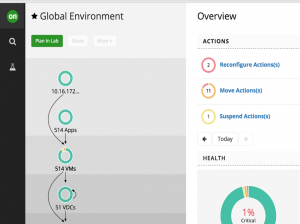Vendor Brief: Turbonomic
I’ve blogged about Turbonomic before- when they evolved from VMTurbo in 2016 and at VMworld 2017 in Barcelona I had a sit down with Perry and Giampiero from the company to see where the product was at 12 months on.
This is a single product company- “Turbonomic” is both the company name and the product name. The product “enables workload self-management” - in a nutshell monitors the environment to ensure that whenever possible applications are given the resources they require. Consider this at its core to be “DRS on steroids”- I was told they can get a density of 30% more VMs per host compared to normal VMware DRS.

The thinking behind the resource allocation by Turbonomic is very focussed on a desired state, rather than looking out for something broken they look at the situation from another perspective by defining what a good state looks like and then worrying about how to get there. To get to this good state the software will take into account placement (host, datastore etc), scaling (looking for oversized VMs as well as undersized), and the capacity of resources available.
The Turbonomic software tries to look at the big picture of the estate- for example “will migrating a hot virtual machine using high CPU onto a new host have a knock on effect on the memory available to other VMs already present on that host?”. The aim, as with any resource scheduler, is to make the best use of the resources available and when an application has a requirement for certain resources it will find the best location and (in Turbonomic’s case) size for that VM.
One example application of this resizing process that was suggested is the deployment of new VMs. Rather than deploying T-shirt sized VMs a company could just deploy “Small” and then Turbonomic could automatically scale those VMs up (or down) through their lifecycle to ensure that the application had the resources it required (subject to availability). In my opinion this sounds like an improvement over the normal “T-shirt” model as it allows more flexibility for applications which need more memory, or more CPU, but perhaps not both. If VMs are sized according to their current requirements, rather than their original template this must surely reduce wastage and therefore potentially save money.

Public clouds are obviously an important tool when manipulating workloads that can scale on demand, and unsurprisingly Turbonomic has integrations here. As well as being able to negotiate with your on-premises environment, the software can talk to the major cloud providers. This provides additional benefits as an oversized VM in the cloud can have big financial implications and the ability to automatically downsize is possibly more important here than in an on-premises environment. Also in the modern multi-cloud world Turbonomic can monitor cloud pricing across vendors along with real-time workload usage and suggest moving services to a different provider, including a real pound/dollar/euro/etc figure of how much a migration could save.
In summary, Turbonomic is worth a look if you’re looking to implement a new monitoring solution and want some automation around it, or if you are looking to reduce your outlay on servers in your own datacentre or your monthly bill from the public cloud.
Beginners Guide to…. Turbonomic
What does it do?
Monitors your environment and moves and scales workloads to give them the resources they need wherever possible.
What do I need to buy?
Turbonomic is a virtual appliance with licensing based on the physical core count or virtual machine count. There is a free 30-day trial.
How do I use it?
Deploy the OVA to your environment and point it at vCenter (and any cloud providers). Management of the product is via a web interface.
Where can I find out more?
Please read my standard Declaration/Disclaimer and before rushing out to buy anything bear in mind that this article is based on a sales discussion at a trade show rather than a POC or production installation. I wasn’t paid to write this article or offered any payment, although I did pick up a branded drink bottle.